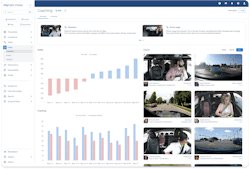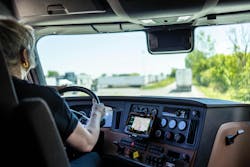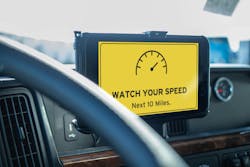AI and automation drive the next era of commercial vehicle safety
Key takeaways
- AI-powered coaching and dashcams prevent accidents by providing real-time feedback and reinforcing safe driving behaviors.
- Digital inspections and automated maintenance workflows reduce downtime, improve compliance, and ensure vehicles are road-ready.
- Predictive analytics and integrated safety systems shift fleets from reactive responses to proactive risk management.
Fleet safety’s digital evolution is driving a powerful transformation in transportation. While new technologies promise to make roads safer, the pace of change can be overwhelming. For safety-focused managers, the emerging challenge is determining which tools are best suited for your operations and preparing for the future of fleet safety.
To address these contemporary challenges, FleetOwner reached out to several leading transportation technology providers to ask about the solutions fleets are underutilizing and to predict where commercial vehicle fleet safety is headed in the second half of this decade.
The most powerful safety solutions aren’t just about installing more devices inside and outside the cab; it’s about connecting every aspect of fleet operations—from the vehicle’s maintenance records to in-cab coaching—to build an intelligent ecosystem.
How AI-driven driver coaching is transforming fleet safety performance
“With labor shortages, rising insurance premiums, and mounting safety challenges, fleets know driver coaching is critical, but timely, consistent coaching remains one of the biggest roadblocks to safety,” Nihar Gupta, product leader for Motive, told FleetOwner. “The old approach—manual, inconsistent, and time-consuming—simply doesn’t scale."
He noted that a safety manager can be responsible for coaching hundreds of drivers. Suppose each coaching session takes at least 30 minutes. In that case, feedback on unsafe events might not be shared with drivers until weeks after they happened, “creating unnecessary safety and liability risks for the entire fleet.”
Motive, a fleet management and driver safety platform, offers Motive AI Coach, which Gupta said delivers personalized, high-quality feedback to drivers at scale using coaching videos generated by artificial intelligence.
“This means fast, consistent guidance for every driver, translating to stronger safety outcomes that reinforce safe driving behaviors and help prevent future incidents,” he explained.
Rival fleet technology provider Samsara is also embedding more AI tools in its solutions. “Many fleets are still not tapping into the life-saving potential of AI-powered cameras and the real-time, in-cab alerts they unlock,” Johan Land, Samsara SVP of product engineering, told FleetOwner. “While dashcam usage has climbed in recent years, the predictive power of AI-powered cameras has yet to be fully embraced.”
At its full potential, AI cameras offer more visibility and predictive power with in-cab alerts that Land likened to an extra set of eyes acting as a real-time safety copilot.
“First and foremost, this technology is about keeping drivers and communities safe,” he explained. “By adopting AI-powered cameras more widely, fleets of all sizes can benefit from accident prevention, lower insurance and litigation costs, and an improved safety culture.”
According to Samsara, customers such as Memphis Light, Gas & Water saw “a 100% reduction in safety events” after adopting Samsara’s AI-based in-cab alerts. Another customer, Eurovia USA, saw unsafe mobile device usage drop by 80%.
Charlie Elliott, Geotab SVP of marketing, called AI-powered dashcams with in-cab coaching “the most underutilized safety technology today.”
“Many fleets still treat safety as a reactive exercise, responding to incidents after they have happened,” Elliott told FleetOwner. “This approach misses the chance to prevent accidents in the first place and to identify risk before it leads to an issue.”
Similarly, Geotab’s AI technology provides drivers with instant voice feedback that encourages self-correction of risky behaviors, such as phone use or tailgating. In a recent Geotab pilot program, Elliott said the technology resulted in a 90% reduction in tailgating and a 95% drop in unsafe phone use.
“For fleet managers, precision AI makes a critical difference by minimizing false alerts and surfacing only the most urgent and relevant events,” Elliott explained. “This removes the need to sift through hours of footage, allowing managers to focus on targeted coaching and long-term behavior change.”
Digital vehicle inspections and maintenance automation strengthen fleet safety compliance
While in-cab coaching can improve driver safety, ensuring the vehicle itself is in top shape is another vital step to prevent significant incidents before a trip begins.
“One safety solution that deserves far more attention from fleets is Zonar’s electronic vehicle inspection reporting system (EVIR) or DVIRs,” Jason Craven, CTO at Zonar, told FleetOwner. “It’s not new, but it’s incredibly important. Built to replace paper inspections with a digital system that ensures consistency, accuracy, and accountability, many fleets still treat inspections as a check-the-box exercise.”
Digitizing and standardizing inspection workflows help fleets catch defects earlier, improve maintenance planning, and avoid costly compliance issues, according to Craven. “It builds accountability into daily operations and streamlines communication between drivers and maintenance teams,” he added.
Brianna Perry, product marketing manager at Fleetio, said fleets are underutilizing inspection workflow automation.
“So many activities related to safety management are still extremely dependent on manual intervention, but technology has started to step in and assist with reducing risk and ensuring inspections don’t get skipped,” she told FleetOwner.
Fleetio’s technology uses telematics and real-time logged inspection data to find these potential problems. “However, catching a problem is only the beginning,” Perry said. “Our automation functionality proves its value in the full maintenance cycle, with the ability to ground a vehicle when it’s unsafe, route the repair to a technician, and close the loop once the work is done so the vehicle is ready to roll again.”
She said that fleets using this technology can do a better job of ensuring their drivers are climbing into safe vehicles that won’t require expensive roadside maintenance or towing.
“When fleets integrate automations into their inspections, they’re not just ‘checking a box.’ They’re preventing injuries, reducing downtime, and building a culture where safety is baked into every step of operations,” Perry said.
Jean-Sebastien Bouchard, chief product officer and co-founder of Isaac Instruments, told FleetOwner that an often-forgotten safety technology is integrated, truck-ready navigation.
“While many fleets allow drivers to use their own navigation apps, these are often not optimized for commercial vehicles, leading to unsafe maneuvers such as U-turns or routing through restricted areas,” Bouchard said.
He cited some factors that impede utilization:
- Drivers may dislike the navigation tools provided by their carrier.
- Data fed from the transportation management system (TMS) can be inaccurate.
- Maps are not consistently updated.
- Many systems lack features such as rest stop planning.
Isaac collaborates with Trimble Maps to create a navigation experience designed for commercial drivers. “One that is accurate, intuitive, and tailored to the realities of trucking,” Bouchard said. “We strongly believe all fleet vehicles should have integrated navigation to enhance safety, reduce risk, and improve operational efficiency.”
Leveraging real-time data and predictive alerts to reduce on-road risks and weather-related incidents
More access to external data is another wrinkle in modern fleet safety technology. Drivewyze by Fleetworthy’s Safety+ solution proactively keeps drivers aware of potential hazards ahead, such as weather.
Last winter, Fleetworthy collaborated with a national carrier to test its Safety+ system for minimizing weather-related incidents. The results found that drivers slowed down 62% of the time after being alerted of a severe weather event, according to company data.
“We worked closely with the fleet during the test to create an additional in-cab weather alert sent only to drivers who were not driving appropriately for the weather conditions they were in,” Martin Murtland, Fleetworthy VP of product, told FleetOwner. “It was like having a safety trainer in the cab—but only when needed.”
The fleet was also able to use that data to identify drivers who needed more coaching. Murtland said that customers have seen significant returns on investment by “reducing driver-related incidents during severe weather, speeding, stopping in unsafe locations, and more. Fleets also utilize Safety+ to help optimize costs and alert drivers to areas of high risk for theft and predatory parking.”
After carrier customer Western Express implemented Safety+, it saw a 22% reduction in vehicle incidents. Another, C.R. England, saw its accidents per mile drop nearly 50%, according to Fleetworthy. Murtland added that it can be invaluable during ongoing natural disasters: “During the last hurricane season, Stevens Transport quickly set up Custom Zones for Hurricane Helene to direct drivers away from flooded areas and did not lose a single trailer or any cargo,” he shared.
Bendix Commercial Vehicle Systems’ Wingman Fusion combines radar, cameras, and brakes to create a fully integrated collision mitigation system. TJ Thomas, Bendix director of marketing and customer solutions, believes that vocational and medium-duty fleets aren’t taking full advantage of the technology.
“Sometimes special apparatuses are added to those vehicles that may prohibit Fusion from being available, yet we still find many fleets don’t spec the technology even when it is offered,” he told FleetOwner. “However, Fusion’s robust feature set—including autonomous emergency braking (AEB), following distance alerts (FDA), overspeed alert and action (OSA), and more—provides benefits for all types of commercial vehicles, including vocational and medium duty.”
Balancing AI innovation with human intelligence to build ethical, trustworthy fleet safety systems
Solera’s Sean Ritchie, VP of sales, has been urging industry leaders this year not to rely solely on nascent AI technology, particularly for in-cab video operations and coaching.
“AI is only as strong as the data and direction it’s given,” he told FleetOwner. “That’s why Solera takes a hybrid, human-in-the-loop approach—ensuring our models don’t learn in a vacuum but with continuous human review, refinement, and accountability.”
Solera’s video-based safety solutions use AI guided by HI (human intelligence). “When you’ve been pioneering fleet safety for more than four decades, you understand the value of the knowledge you've acquired,” Ritchie explained. “That is why our AI systems are built with human intelligence, data integrity, and ethics at the core.”
Solera utilizes human safety professionals to verify AI-detected events, resolve edge cases, and assist in training the system. Ritchie said this dramatically reduces false positives, improves scoring accuracy, and ensures drivers buy into the coaching. He also said this is part of Solera’s “Ethical AI” mission: transparent models, high-quality data, and ethical oversight.
“Fleets that rely solely on AI-based alerts or automated praise see little improvement in risk, while fleets that use human-reviewed coaching see measurable safety gains,” Ritchie said. “That’s how Solera builds trust, and why fleets that fully embrace our AI+HI approach see fewer collisions, stronger driver engagement, and better outcomes across the board.”
About the Author
Josh Fisher
Editor-in-Chief
Editor-in-Chief Josh Fisher has been with FleetOwner since 2017. He covers everything from modern fleet management to operational efficiency, artificial intelligence, autonomous trucking, alternative fuels and powertrains, regulations, and emerging transportation technology. Based in Maryland, he writes the Lane Shift Ahead column about the changing North American transportation landscape.





